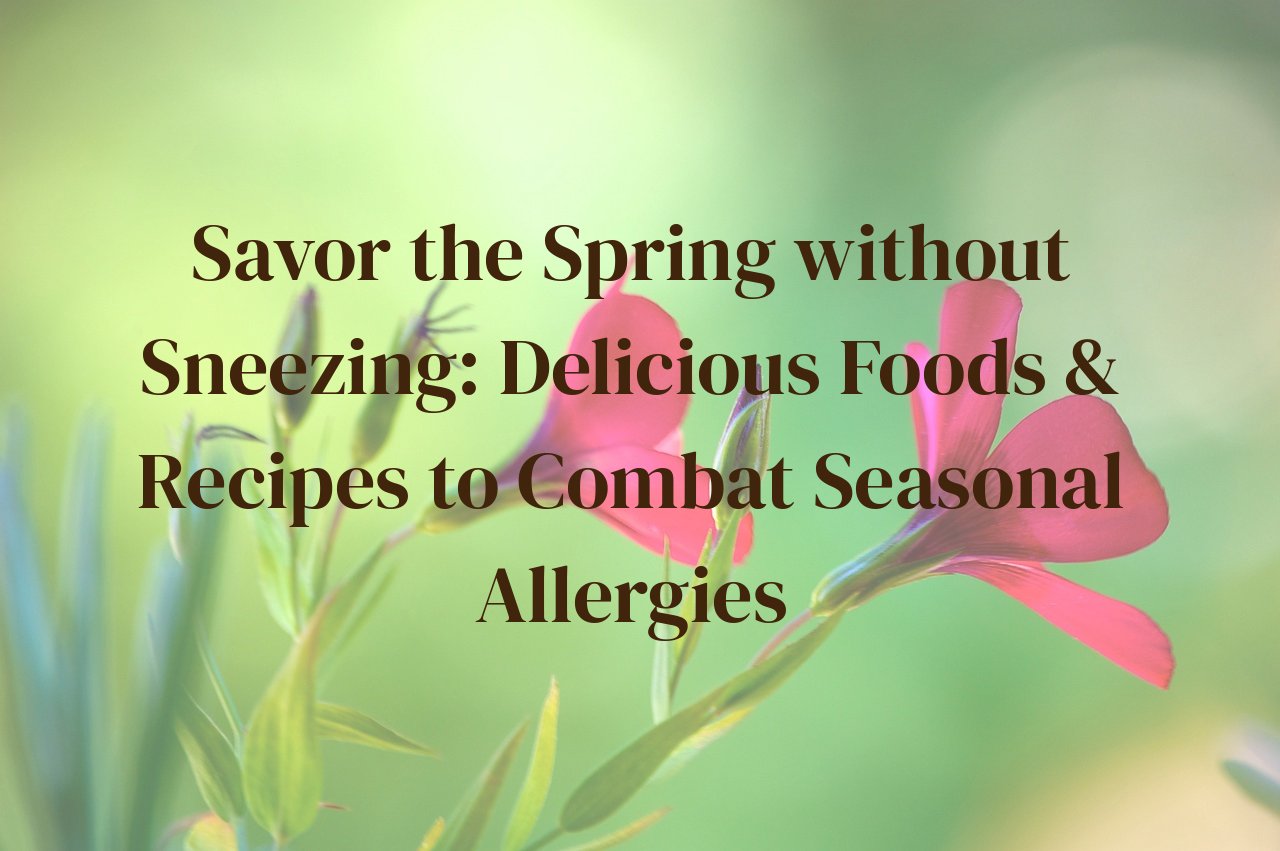
As the blossoms unfurl and the daylight stretches, spring brings with it a tide of beauty along with a sneeze-inducing sidekick: allergies. In this post, we’re diving into an array of foods and easy-to-whip-up recipes tailored to ease the seasonal sniffles. Delight in your springtime adventures fortified by the right nutrients to keep allergies at bay. Prepare to discover how to transform your pantry into a bastion against springtime allergens and why the culinary approach might just be the ally your immune system has been waiting for.
Table of Contents
Understanding Spring Allergies: The Culinary Defense
As spring unfurls its verdant splendor, many of us greet the blossoming world with a less-than-warm welcome, dreading the onslaught of seasonal allergies. Amidst the sniffling and sneezing, there’s a beacon of hope in the form of dietary choices that can bolster our bodies’ defenses. Making informed food selections isn’t merely about enjoyment; it’s about constructing a culinary barricade against the relentless pollen.
It all comes down to the immune system. Essentially, spring allergies are the result of an overzealous immune response to harmless substances like pollen. In a well-intentioned but misguided mission, the body unleashes histamines, bringing about the all-too-familiar symptoms. Now, how can certain foods help? Foods rich in omega-3 fatty acids, such as flaxseeds and walnuts, have been shown to possess anti-inflammatory properties that can help reduce the severity of allergic reactions.
Incorporating local honey into your diet is another strategy I’ve personally embraced. The theory is akin to a natural vaccine: by consuming honey produced by bees in the same environment, you may help your body acclimate to the local pollen, potentially desensitizing your immune system. While scientific evidence isn’t conclusive, many swear by this delicious remedy, and I’ve found it brings a touch of sweet relief to my springtime woes.
Another player in our culinary arsenal is vitamin C – a natural antihistamine. Foods replete with vitamin C like oranges, strawberries, and bell peppers can aid in mitigating the body’s histamine response. Quercetin, a flavonoid present in apples, berries, and onions, also steps up as a natural antihistamine and anti-inflammatory agent, offering a one-two punch against those seasonal sniffles.
A diet diverse in these nutrients offers more than just a palatable experience; it forms a dietary bulwark, reinforcing our immune system’s ability to fend off allergic reactions. As I’ve incorporated such foods into my spring routine, I’ve noticed a marked improvement in my daily comfort. Let’s wrap our forks and spoons around the promise of a sneeze-free season, one flavorful bite at a time.
The Anti-Allergy Pantry: Essential Foods for Spring
Embarking on spring with a history of allergies can feel like stepping onto a battlefield, yet proper ammunition in the form of certain foods can be your culinary shield. Let’s unpack my pantry, which I’ve learned to stock with anti-allergy staples to ward off the seasonal sneeze-fest.
Local Honey comes first. Not just sweetness in a jar, local honey may contain traces of local pollen, which, when consumed in small doses, might help accustom your body to these allergens, reducing the sensitivity over time. While scientific jury is still out, I swear by a daily spoonful that seems to lessen my hay fever symptoms.
Brimming with Quercetin, a natural antihistamine, onions and apples have carved out a sacred place in my Spring pantry. These foods might down-regulate histamine production – sort of like an internal off switch for allergic reactions. Chopping onions for a salad or biting into a crisp apple, I find relief knowing I’m giving my body a fighting chance against the pollen onslaught.
Omega-3 powerhouses, like wild salmon and flax seeds, are my go-to foods when I’m looking for something more substantial that combats inflammation associated with allergies. The Omega-3 fatty acids are like balm, soothing our body’s inflammatory response, hearkening a welcome respite from allergy agonies.
Then there’s the vibrant ginger root, a zesty companion that not only zings up my palate but also wages war on inflammation and can suppress allergic reactions with its robust properties. If I feel a tingle in my throat, a ginger infusion is my elixir of choice, calming and fortifying me against the breezy pollen invaders.
Lastly, I’ve discovered the treasure of probiotics in kefir and yogurt, which I’ve concluded aren’t just good for gut health. By enhancing my gut flora, I’m bolstering my immune system – a crucial ally in my body’s complex network that determines how it will react to environmental irritants. In essence, each spoonful is a step toward a sneeze-less spring.
Navigating the changing seasons with food as my companion has been enlightening. Harnessing the power of these carefully chosen pantry items, I arm myself each spring not merely with nutrients, but with co-conspirators in the gentle battle against one of nature’s small yet mighty forces: allergens.
Simple Recipes to Mitigate Seasonal Allergic Reactions
As someone who has navigated the challenging path of seasonal allergies, discovering the culinary strategies that help manage my symptoms has been a game-changer. Below are some simple, yet effective recipes brimming with anti-inflammatory and antihistamine properties to help soothe spring allergies.
1. Quercetin-rich Apple and Onion Sauté: Quercetin, found in abundance in apples and onions, is a natural antihistamine. My go-to recipe begins by thinly slicing one organic apple and one red onion. I sauté them in a touch of olive oil until tender and fragrant. This delectable side dish not only helps stabilize mast cells to reduce histamine release, it also blends sweet and savory to perfection.
2. Omega-3-packed Grilled Salmon with Herbs: Incorporating omega-3 fatty acids is a must for combating inflammation. I relish grilling a salmon fillet and garnishing it with a mix of fresh herbs like dill, parsley, and chives, all of which contribute anti-inflammatory benefits. This dish has been a lifesaver on days when allergies hit full force.
3. Bioflavonoid-laden Citrus Honey Ginger Tea: A soothing elixir that I swear by consists of freshly brewed tea made with sliced ginger, lemon, and a spoonful of local honey. The ginger acts as a natural antihistamine, while the vitamin C in lemon boosts the immune system. Local honey provides incremental exposure to pollen and can aid in building up tolerance.
4. Probiotic-rich Yogurt with Berries and Honey: A bowl of Greek yogurt topped with an assortment of berries creates a delightful breakfast or snack. The probiotics in yogurt sustain gut health, essential for immune function, whereas berries and honey are packed with allergy-fighting compounds. This combination has been a delightful way to start my day without the worry of triggering my allergies.
Each of these recipes has not only brought joy and comfort to my palate but also has become a valuable part of my strategy to stand strong against springtime allergies. Their natural ability to reduce my body’s histamine response has allowed me to embrace the season with enthusiasm and without sneezes!
Navigating Meals Out: Allergy-Friendly Options When Dining Away from Home
Dining out during spring’s bloom can be a sneeze-inducing hardship for those with seasonal allergies. Yet, embracing the gastronomic delights of the season need not be off the menu. On my own quest to quell the sniffles, I’ve become a connoisseur of safe culinary havens and choices that allow me to bask in the ambiance of my favorite eateries without the fear of an allergy flare-up.
One of the most soothing options I’ve discovered is starting with a warm broth-based soup. Soups like miso or a simple vegetable broth can be incredibly comforting and are less likely to contain allergenic ingredients like dairy or wheat. Plus, the steam may help open up the sinuses, providing a temporary reprieve from congestion.
Salads might seem a safe bet, yet beware of hidden culprits like nuts or raw onions that can worsen symptoms. I opt for fresh leafy greens such as spinach or kale, topped with grilled chicken or fish and dressed in a simple homemade dressing. When in doubt, asking the chef to customize your salad is a smart move.
For entrees, I gravitate towards simple grilled proteins like salmon or chicken. These options are not only healthy and nourishing but also less likely to interact with common allergy triggers. I pair these with steamed vegetables or a plain baked potato. The simpler the preparation, the more control I have over what I’m consuming and the less risk there is of exposure to allergens.
Asian cuisine offers a variety of rice-based meals which are generally safe. I am particularly fond of sushi – it’s simple, fresh, and typically free of dairy and wheat. However, it’s essential to be wary of soy sauce, which contains wheat, and opt for a gluten-free version if you’re sensitive.
To satisfy my sweet tooth, I stick to fruit-based desserts like sorbet or baked apples with cinnamon. These options are devoid of dairy and flour, common allergy aggravators, and still provide a delightful end to the dining experience.
Throughout my dining explorations, I’ve learned that communication is key. I make it a habit to converse with servers or chefs about my allergies, ensuring they understand my dietary needs. Many restaurants are accommodating and can suggest or alter dishes to be allergen-friendly – after all, they aim to provide a safe, enjoyable dining experience for all patrons, sniffle-free.
Personal Reflections: My Journey with Food and Allergies in Spring
Every year, as the frost thaws and the foliage burgeons, I am reminded not only of nature’s rebirth but also of the inevitable skirmish that ensues within my immune system. Spring for me has always been a time of dichotomy, where appreciation for blooming beauty is entwined with the distress of seasonal allergies. As the flowers unfurl their petals, my allergies seem to uncurl their grip on my well-being, provoking a symphony of sneezes and an orchestra of itches.
My journey with food and allergies in those vernal months has been transformative, a personal quest for culinary solace amidst the sniffles. Through trial and error, and with a pinch of optimism, I came to discover that certain foods possess the power to mitigate the severity of my allergy symptoms. Local honey became my morning elixir, a natural remedy believed to acquaint my immune system with the local pollen, thereby lessening my reactions. It was the sweet spoonful of hope that began each day with a promise of relief.
Omega-3 rich foods like flaxseeds and walnuts found their way into my pantry, praised for their anti-inflammatory properties. Integrating them into my diet meant crafting innovative recipes, such as a walnut-encrusted salmon that seemed to soothe my symptoms. The zesty aroma of freshly grated ginger, known for its ability to suppress allergic reactions, became a staple in my tea and stir-fry dishes, infusing both my meals and my nasal passages with a refreshing clarity.
With every passing spring, I grew more adept at reading the signals of my body, learning that foods like yogurt with live cultures were beneficial for my gut health, and consequently, my overall immune response. My diet became a colorful tapestry of bioflavonoid-rich fruits and vegetables like berries and leafy greens, which I believed to have bolstered my defense against the allergen onslaught.
But the journey wasn’t confined to the sanctuary of my home. Dining out amidst the blooms necessitated vigilance and dialogue with restaurant staff to ensure allergy-friendly options. I learned to savor the safety of grilled proteins and steamed vegetables when the spring air was thick with pollen.
Walking this path of seasonal self-discovery wasn’t just about silencing the sneezes—it was about learning to embrace the rhythms of the seasons. It was about nurturing resilience within, so I could savor the blossoming world around me without fearing the repercussion of a red nose or watery eyes. As I share my story, it’s with the hope that my springtime saga resonates with others navigating the tempestuous tides of allergies, and perhaps even offers a beacon of relief where ordinary medicine falls short.
Conclusion
Embracing the season of renewal doesn’t have to mean suffering through a symphony of sneezes and sniffles. By incorporating certain foods into your daily meals, you can equip your body to better tackle the allergens that abound. I’ve shared the sustenance strategies that have turned my springs from dismal to delightful, and I hope you’ll find respite in these recipes as well. Remember, the freshest flavors of the season can be your delicious antidote to the allergy tumult.



